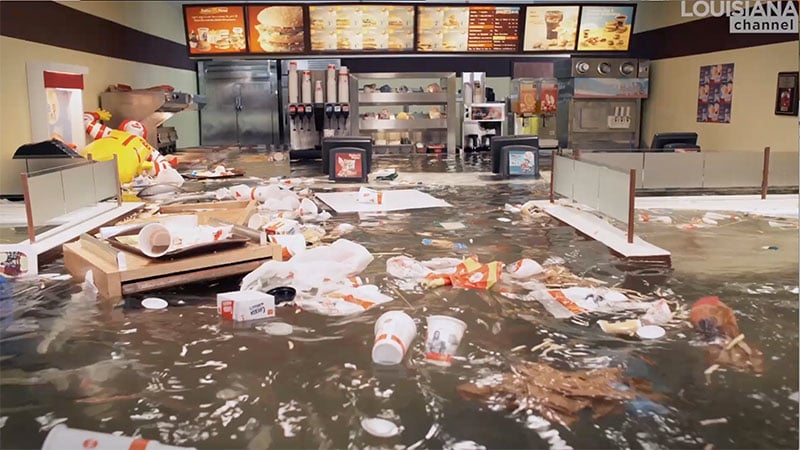
What motivates a Danish artists' group Superflex to make a movie where one of the most famous American fast food restaurants is inexplicably flooded?
Superflex’ starting point was to focus on the idea of the mass-production of food, and they felt that the most heavily branded fast food restaurant was McDonald’s. They built the restaurant from scratch, basing it on what a McDonald’s would have looked like in the 1980s, as they believed that this was perhaps the most iconic image of it. Every detail – down to the small boxes for Happy Meals – were handmade in a studio in Bangkok. The adding of water functioned as a melt-down of the restaurant but at the same time made the different things in it come to life: “All these dead objects start to become actors.” Moreover, the water also created limitations in the set, as it was not possible to undo – they could stop more water from coming in, but not reverse the consequences of the water that was already there.
The film is shot around 2008, where there were “a lot of post-apocalyptic scenarios going on.” The financial crisis, global warming and such took up a lot of space in the media, and Superflex wanted to make their own version of this “end-of-the-world” set-up “in a mild Scandinavian way, but still using some kind of global vocabulary – the raising of the water, the most famous fast-food chain.” Though the movie is heavy on the use of symbolism, the approach is also quite humorous: “It’s almost like slapstick.”
Superflex is a Danish artists' group founded in 1993 by Jacob Fenger, Rasmus Nielsen and Bjørnstjerne Christiansen. They describe their projects as 'Tools'. A tool being a model or proposal that can actively be used and further utilized and modified by the user. Their oeuvre spans from beer (‘Free Beer’) and soda (‘Guaraná Power’) to alternative energy production methods to movies and installations, and their projects are often related to economic forces, democratic production conditions and self-organization. Superflex have gained international recognition for their projects and have held solo exhibitions at venues such as Kunsthalle Basel in Switzerland, Schirn Kunsthalle in Frankfurt am Main, REDCAT Gallery in Los Angeles, Mori Museum in Tokyo and the Hirshhorn Museum and Sculpture Garden in Washington D.C. Furthermore, they have participated in art biennials such as Gwangju Biennial (Korea), Istanbul Biennial, São Paolo Biennial, Shanghai Biennial and in the ‘Utopia Station’ at the Venice Biennale.
comments